Suicide remains one of the greatest threats to student safety, and at Lightspeed Systems, we take this issue very seriously. Our commitment to understanding student behavior drives us to develop life-saving interventions, particularly for those struggling with mental health challenges. This dedication is shared across all levels of our organization, from leadership to staff and clients. In fact, it’s one of the core reasons for Lightspeed Systems’ existence. Our President and CEO, Brian Thomas, experienced the impact of suicide personally through the loss of a family friend’s child. Driven by a determination to prevent such tragedies, Lightspeed has been on a mission to equip school districts and safety teams with the tools and support necessary to keep students safe.
As we come together for Suicide Prevention Awareness Month, it’s important to highlight how technology can play a vital role in protecting our students. By monitoring suicide-related searches and conversations happening on school-issued devices, we can spot potential risks in students’ online activities. This allows staff to respond quickly and offer the support that students desperately need.
In our efforts to raise awareness, we analyzed Lightspeed Alert data with a closer look at the thousands of flagged alerts related to self-harm and suicide contemplation from the 2023-24 school year. What we found revealed some troubling trends in what students are searching for online. Here’s what we uncovered:
*Please note our data collection and findings are generalized and anonymized to protect student data privacy. You can read more about our commitment to privacy here.
Looking at the Data
Lightspeed Alert Data in Comparison to National Trends
We recently published a blog about the CDC’s encouraging report on student mental health improvements from 2021 to 2023. Their findings show a slight decrease in students experiencing persistent feelings of sadness or hopelessness, as well as a decline in those seriously contemplating suicide or making plans.
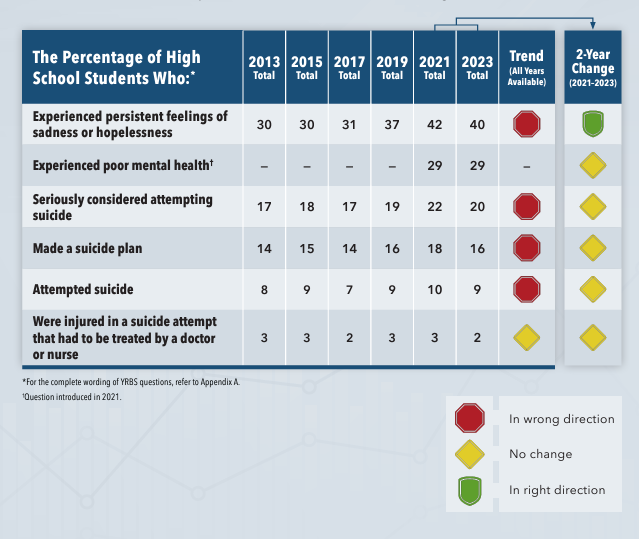
Source: YRBS Data Summary & Trends Report
We’re also experiencing similar positive trends in youth mental health, which can be attributed to the unwavering dedication of parents, teachers, counselors, and school communities. However, after digging deeper into the data, we still have more work to do.
How Self-Harm Stacks Against Overall Incidents
During the 2023-24 school year, Lightspeed Alert flagged over 2.4 million incidents. Out of those, more than 1 million were recognized as legitimate concerns for student safety by Lightspeed’s human review team. Alarmingly, 13.1% of these incidents were related to self-harm, impacting 73,960 students. This means that, on average, each student who faced self-harm had about 1.85 incidents. Additionally, a significant 88% of the self-harm alerts that the human review team investigated were passed on to the schools or districts for further action.
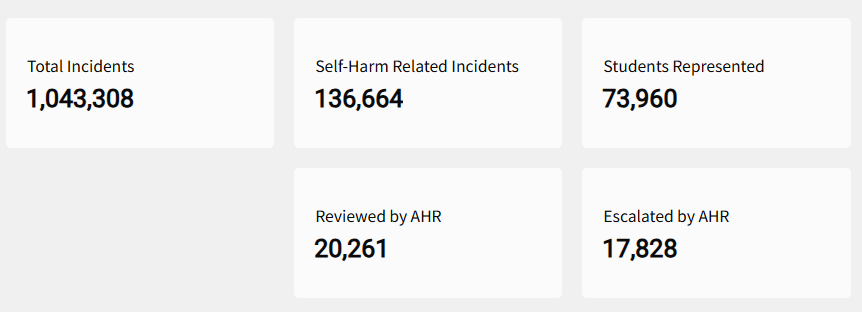
Overall incidents reported by Lightspeed Alert—including self-harm, bullying, violence, weapons, drugs, and explicit content—generally increase toward the end of the school year (March to May). In contrast, self-harm-related incidents tend to rise in the first semester as students return to school (September to October).
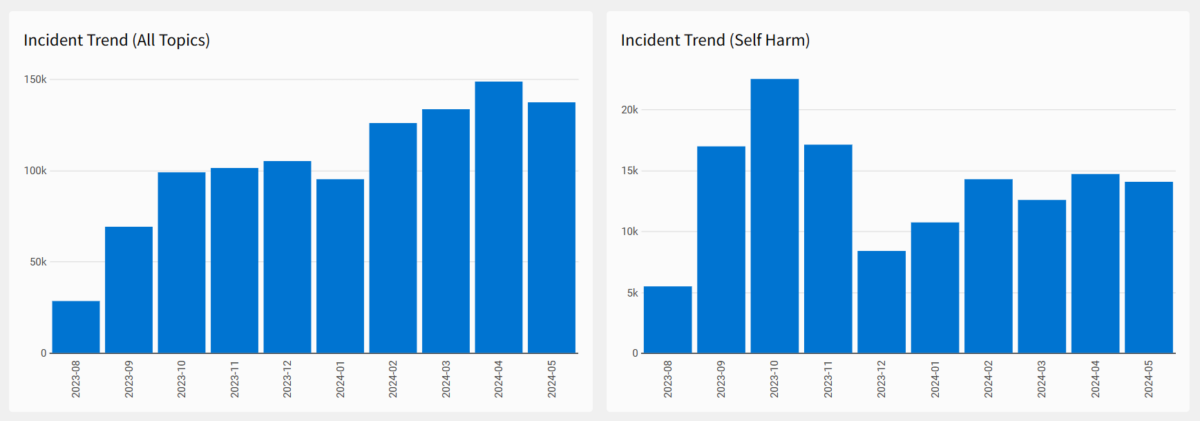
Interestingly, this trend is especially significant since September is recognized as Suicide Prevention Awareness Month. In support of this trend, a study conducted by Understood.org found that more than half (53%) of parents with children under 18 believe that the back-to-school season is the most stressful time of the year. “Every summer must end, and anxiety is a natural response to change and the unknown, whether that’s new teachers and classes, a new friend group or the first day of high school,” as quoted by The Washington Post regarding back-to-school anxiety.
Self-Harm and Suicide-Related Incidents by Source
When examining the data on the sources students use to communicate about self-harm and suicidal thoughts, we felt both alarmed and relieved by the insights provided by Lightspeed Alert. The breadth of data captured underscores the critical role of Lightspeed’s device-level agents, especially when combined with product integrations. Notably, 64.14% of self-harm and suicide-related alerts were flagged specifically by Lightspeed Alert Agents. These alerts are crucial, as they likely would have gone unnoticed by many other student safety products that depend solely on integration scanning. This highlights the effectiveness of our approach in identifying and addressing these serious issues among students.

- 64.14% identified by Lightspeed Alert Agents
- 24.46% identified by Google Drive Integration
- 4.62% identified by Gmail integration
- 6.51% identified by Microsoft Outlook integration
- 0.28% identified by Microsoft Teams integration
Top Online Sources Where Concerning Self-Harm Content is Accessed/Entered
While Google products are most used, it’s crucial to recognize that Lightspeed Alert goes beyond that by scanning for concerning indicators across various platforms, including online documents, websites, social media, and more—essentially anywhere students are engaged in learning. This capability allows Lightspeed Alert to capture indicators in real time, providing valuable context such as student searches within browser search bars and even deleted text in online documents.
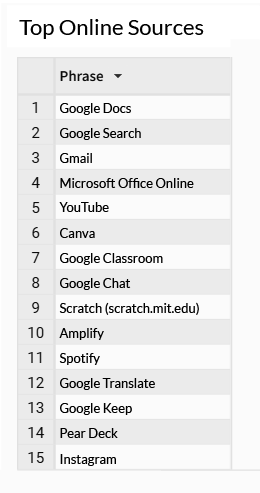
- Google Docs
- Google Search
- Gmail
- Microsoft Office Online
- YouTube
- Canva
- Google Classroom
- Google Chat
- Scratch (scratch.mit.edu)
- Amplify
- Spotify
- Google Translate
- Google Keep
- Pear Deck
Top 20 Self-Harm Related Phrases Used Within the Last 30 Days
Top student content (searches, documents, chats, etc.) related to self-harm typically includes the following phrases, representing over 23,000 alerts within the last 30 days. Note “suicide” as the number 1 spot and other notable slang phrases such as “kms” and “imma kms.” Additional common slang phrases just shy of the top 20 list were “su/c/de,” “sewerslide,” and “unalive myself.” Lightspeed Alert utilizes adaptive AI and machine learning to locate, contextually interpret, and surface warning signs; so, as student language evolves, so does Lightspeed.
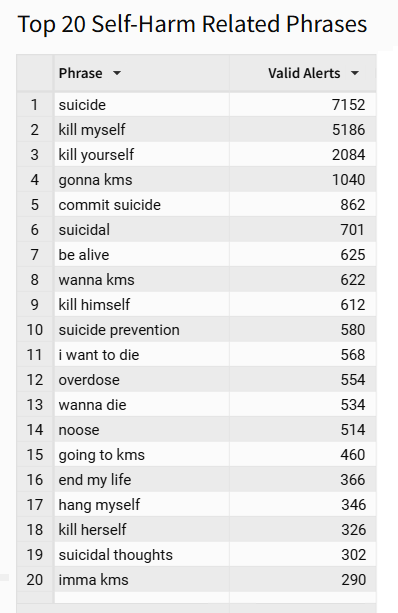
- suicide
- kill myself
- kill yourself
- gonna kms
- commit suicide
- suicidal
- be alive
- wanna kms
- kill himself
- suicide prevention
- i want to die
- overdose
- wanna die
- noose
- going to kms
- end my life
- hang myself
- kill herself
- suicidal thoughts
- imma kms
Conclusion
While kids may not always show visible signs of distress, they are confiding in their devices. That’s why K-12 alert scanning technology is vital for protecting our students. Although we are seeing signs of mental health improvement, the reality of suicide remains a critical concern for student safety. By understanding these trends, school districts and safety teams can actively monitor student activity and address critical issues before an incident occurs.
This proactive approach not only helps in identifying potential risks but also fosters an environment where students feel seen and heard. When schools utilize these tools effectively, they can implement timely interventions, connect students with the necessary resources, and ultimately save lives. By sharing these findings, we aim to raise awareness and cultivate a community dedicated to supporting our students’ mental health. We encourage parents, educators, and community members to work together in this mission. Together, we can strive to create a safer, more supportive environment for all, ensuring that every student has the chance to thrive.
Lightspeed Systems partnered with the American Foundation for Suicide Prevention, and district leaders across the nation to discuss the current state of mental health, and the effects of its increase over the past 18 months. Hear life-saving stories from a Lightspeed Safety Specialist and learn how your district can prepare for an effective prevention, intervention, and post-intervention program this school year.

